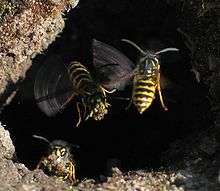Aculeata
Aculeata is a subclade of Hymenoptera. The name is a reference to the defining feature of the group, which is the modification of the ovipositor into a stinger (thus, the group could be called "stinging wasps", though the group also contains the ants and the bees). In other words, the structure that was originally used to lay eggs is modified instead to deliver venom. Not all members of the group can sting; a great many cannot, either because the ovipositor is modified in a different manner (such as for laying eggs in crevices), or because it is lost altogether. A large part of the clade is parasitic.
| Aculeata | |
|---|---|
 | |
| Vespula vulgaris | |
| Scientific classification | |
| Kingdom: | Animalia |
| Phylum: | Arthropoda |
| Class: | Insecta |
| Order: | Hymenoptera |
| Suborder: | Apocrita |
| Infraorder: | Aculeata (but see text) |
| Superfamilies | |
This group includes the bees and ants and all of the eusocial Hymenopterans. It is commonly believed that the possession of a venomous sting was one of the important features promoting the evolution of social behavior, as it confers a level of anti-predator defense rarely approached by other invertebrates.
Classification
The use of the name Aculeata has a long history at the rank of infraorder or division. The Aculeata are a monophyletic, or good natural group, containing all the descendants of a single common ancestor. The Aculeata are therefore maintained as a taxon, either at infraorder or division rank or as an unranked clade.[1][2][3][4][5]
| Aculeata |
| ||||||||||||||||||||||||||||||
References
- Johnson, Brian R.; Borowiec, Marek L.; Chiu, Joanna C.; Lee, Ernest K.; Atallah, Joel; Ward, Philip S. (2013). "Phylogenomics resolves evolutionary relationships among ants, bees, and wasps". Current Biology. 23 (20): 1–5. doi:10.1016/j.cub.2013.08.050. PMID 24094856.
- Branstetter, Michael G.; Danforth, Bryan N.; Pitts, James P.; Faircloth, Brant C.; Ward, Philip S.; Buffington, Matthew L.; Gates, Michael W.; Kula, Robert R.; Brady, Seán G. (2017). "Phylogenomic Insights into the Evolution of Stinging Wasps and the Origins of Ants and Bees". Current Biology. 27 (7): 1019–1025. doi:10.1016/j.cub.2017.03.027. PMID 28376325.
- Schulmeister, S. (2003). "Simultaneous analysis of basal Hymenoptera (Insecta), introducing robust-choice sensitivity analysis". Biological Journal of the Linnean Society. 79 (2): 245–275. doi:10.1046/j.1095-8312.2003.00233.x.
- Schulmeister, S. "Symphyta". Retrieved 28 November 2016.
- Peters, Ralph S.; Krogmann, Lars; Mayer, Christoph; Donath, Alexander; Gunkel, Simon; Meusemann, Karen; Kozlov, Alexey; Podsiadlowski, Lars; Petersen, Malte (2017). "Evolutionary History of the Hymenoptera". Current Biology. 27 (7): 1013–1018. doi:10.1016/j.cub.2017.01.027. PMID 28343967.
External links
- Tree of Life Web Project: Aculeata
- Bugguide.net: Aculeata
- Johnson, B. et al. Phylogenomics resolves evolutionary relationships among ants, bees, and wasps. NCBI